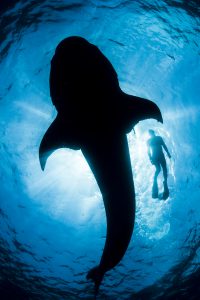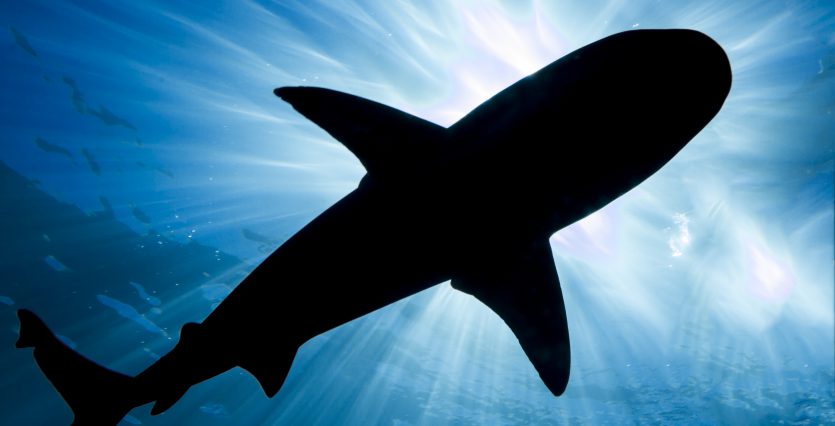
Be in the audience when a photographer projects a beautifully shot silhouette, and after a moment of silence, you are almost certain to hear “oohs” and “aahs” of appreciation. Those audible gasps are proof that strong silhouettes command viewer attention. As an underwater photographer, the question to ask yourself is” “How can I create silhouettes that have a WOW factor?” The good news is that creating powerful silhouettes really isn’t all that hard to do.
Finding the right subject in favorable conditions at the right time of day is the biggest challenge. When composing a silhouette, you want to look for:
1) a black, or near black, looking subject that has an interesting shape and that is in relatively shallow water, and
2) distinct contrast between the darkly hued subject and bright surrounding water.

If you do not have these factors working for you, you need to change something. That something might be your angle of orientation to your subject, the distance to your subject, or your depth etc. But you will want to do whatever it is that allows you to see a crisply defined silhouette as you compose your frame.
If you don’t see a well-defined silhouetted subject or you see color or details in your subject when you are composing your frame, even if it is rather faint color or details that are not well defined, you need to change something so that you see a more distinctly defined silhouette. In short, if your eyes don’t see a crisp silhouette, your camera will not capture one.
From a technical perspective, silhouettes are relatively simple images to make. You won’t be using a strobe and this greatly simplifies the challenge of getting a proper exposure. Shoot in your camera’s manual mode and use your camera’s spot metering option if it has one. Your light meter will help you correctly expose the water that surrounds your subject, and by using spot metering, you can be sure you are taking your light meter reading on the water and not on your dark subject or a combination of the water and subject.
No misprint here. It is the water around your silhouetted subject that you want to properly expose. Your subject should appear dark, or way under exposed, in your photograph.
You will want to use a relatively fast shutter speed, a minimum of 1/125th of a second or faster when possible, to help create crisp lines that separate your subject from the surrounding water. Additionally, in scenarios in which streaks of sunlight appear to dance through the water, a fast shutter speed will help capture them, and those light rays can add significant visual appeal.

Since the background in underwater silhouettes is usually bright water that is at or near the surface, you will almost always find a moderate-to-extremely strong upward shooting angle to be very helpful. But looking up and raising your arms into shooting position can cause your exhaust bubbles to “bleed” out of your suit and ascend into your frame, so be aware of this potentially ruinous problem and do what you can to combat it. Experienced shooters often “burp” their wetsuits shortly after entering the water.
If the bright white “ball” of the sun is in your frame, you will want to block the sun with your subject to help create an appealing glow of sunlight around your subject and to prevent you from ruining your photograph by having a grossly overexposed sun ball that draws attention away from your subject an d annoys viewers.
Of course, you don’t have to have the sun in a silhouette. But along with the streaks of sunlight that often appear to radiate around silhouetted subjects that are strongly backlit by the sun, a halo of whitish light that outlines strongly backlit silhouetted subjects can add dramatic impact to silhouettes.
If I had to pick one thing that would help most underwater photographers take the quantum leap forward to producing silhouettes with a wow factor it would be not to think of silhouettes as an afterthought. Instead, I suggest that when you have favorable shooting conditions and a good subject to work with, that you dedicate your dive, or a good portion of it, to creating silhouettes. That is how I created the silhouettes that accompany this piece.

One question I am often asked is how I am able to so quickly establish my camera settings before my subject swims out of my frame when I see a subject I want to silhouette. The answer is, I usually don’t work that way. When I decide to pursue silhouettes, I often take my light meter reading and establish my camera settings long before my subject swims into range. I pay attention to any change in light levels that will occur if the sun goes behind or pops out from behind a cloud. But if the light level doesn’t change, all I need to do when my subject gets within range is focus my lens, compose, and shoot.
My takeaway message is that silhouettes aren’t technically difficult images to produce. But they don’t just happen either. To get the best results you need to put forth a solid effort, and in the end, if you get things right, you will be greatly rewarded for your effort.


